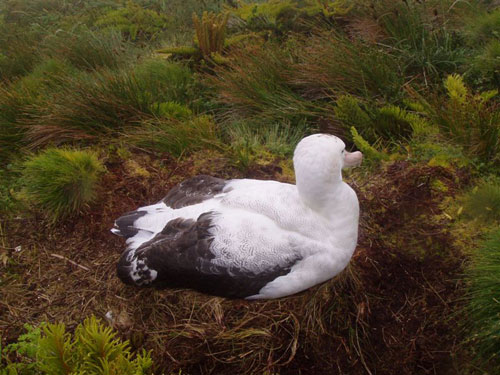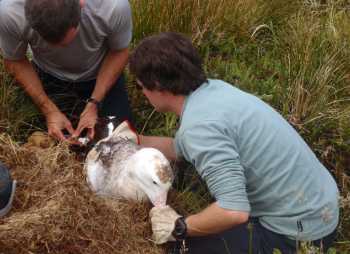In 2007 I initiated a demographic study of the Critically Endangered Tristan Albatross Diomedea dabbenena on Gough Island in the South Atlantic. In three chosen areas (Gonydale, the Hummocks and Tafelkop) all the occupied nests were staked during incubation in January-February and the birds were metal- and colour-banded as well as being measured and photographed for sexing purposes. Up to five repeat visits to each study area were needed to record all the partners.

Later in the year the chicks were banded and breeding success (lamentably very low due to attacks on unguarded chicks in winter months by introduced House Mice Mus musculus) was calculated. I repeated the study in 2008 but from 2009 the project has been managed jointly by the Percy FitzPatrick Institute at the University of Cape Town and the Royal Society for the Protection of Birds in the United Kingdom. Each year since 2009 two RSPB field assistants have been placed on the island and their work has included regular visits to the albatross study sites in the island's mountainous interior.
In January field assistants Ross Cowlin and Nic le Maitre with help from meteorologist Prince Mlongwana commenced year five of the study. From this month Nic, with occasional support from members of the South African weather station on the island, is continuing the study solo: a tricky task given the terrain, the weather and the difficulty of banding and measuring such large birds on one's own.

So far a total of 211 nests has been staked out and the incubating birds checked, and banded if necessary. Repeated return visits at 4-6-day intervals are now required to record all the mates, with one quarter of them recorded at the time of writing.
The study is supported financially by the UK's Overseas Territories Environment Programme and logistically by the South African Department of Environmental Affairs. Ornithological research on Gough Island is conducted with the approval of the Tristan Conservation Department. In the past the Tristan Albatross demographic study has also been supported financially by the Albatross and Petrel Agreement, Birds Australia and the International Association of Antarctica Tour Operators.
With thanks to Nic Le Maitre for information.
John Cooper, ACAP Information Officer, 25 February 2011

 English
English  Français
Français  Español
Español